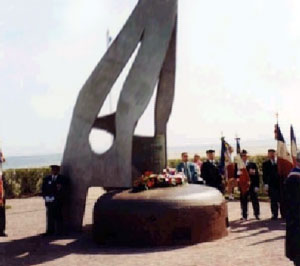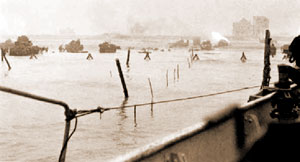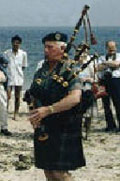Ouistreham and Sword Beach
Ouistreham Riva-Bella
The turret now serves as the base for a modern metal sculpture resembling a flame. As you climb the dune to the turret there are small stone markers inscribed with the names of French commandos who fell on D Day.
Further east along the Ouistreham Riva-Bella sea front are the following points of interest: Two modern stained glass windows in the medieval church in Ouistreham that commemorate the landings, one dedicated to the 1st Special Service Brigade and the other to the memory of the 51st (Highland) Division.
A fifty-foot high observation and fire control tower at the corner of the Avenue de la Plage and the Boulevard du 6 June that was converted in 1988 into The Atlantic Wall Museum. Open daily during summer 09.30-19.00. Admission charge. Bunkers on the east jetty in Riva-Bella, one topped by a steel cupola said to have been brought from the Siegfried Line.

A monument in the center of a round-about on D 514, south of Ouistreham, with a plaque attached to its base commemorating the Anglo-French 4 Commando.
Concrete pyramids leading down to the beach from the Casino were used by German as beach obstacles. A different model was called dragoon's teeth.
Two plaques at No 47 Avenue Pasteur, commemorating the deaths of French commandos nearby.
Sword Beach
Sword is the furthest east of the landing beaches, and was also the smallest, only wide enough for a brigade-sized landing force. The 3rd British Division was tasked with getting enough troops ashore to push inland quickly and seize Caen, and also link up with 6th Airborne Division Early on June 6th Naval Force «S», carrying the assault force and support units, moved into position off the mouth of the River Orne. It was here that the only notable German naval activity of the day occurred, when three E-boats emerged through the Allied smoke screen, fired a salvo of torpedoes, which sank the Norwegian destroyer Largs Svenner, and made off unscathed. It proved to be the only appearance of the Kriegsmarine that day, and the Allied bombardment force, including the battleships HMS Warspite and HMS Ramillies, proceeded to lay down the heaviest barrage of the day on the three-mile wide stretch of beach where the 8th British Brigade was to land. The assault force was made up of the 1st South Lancashire Battalion on the right, heading for Queen White Beach, and the 2nd East Yorks on the left, its target Queen Red Beach. The assault force was preceded by DD tanks of the 13th/18th Hussars, and demolition teams.
Disaster was narrowly avoided when the DD tanks ran into the path of some of the LCTs carrying the demolition teams. In the event, quick thinking and fast manoeuvring enabled 21 out of 25 DD tanks to reach shore safely, just ahead of the infantry, who began to disembark at about 7.30 am. On the right, the 1st South Lancs made rapid initial progress. Within two hours they had cleared three exits from Queen White, and pushed a mile and a half inland to take the village of Hermanville. Just beyond this lay the important landmark of Périers Ridge, but this was strongly held by troops of 21st Panzer Division, with support from 88mm guns, and the British advance stalled on the outskirts of Hermanville, where the South Lancs dug in. Meanwhile, on Queen Red, the East Yorks met determined resistance in clearing enemy strong points, and before this was eventually completed further problems had begun to present themselves. Owing to the prevailing wind, the tide came in both much faster and further than had been expected. As a result the engineers were unable to clear all of the beach obstacles, and follow-up waves of landing craft became severely congested as they tried to find a safe path to shore. To add to British problems, German artillery fire, zeroing in on the barrage balloons flying above the landing zone, was proving unpleasantly accurate.

If the 3rd Division was to reach its planned objectives for the day, both speed and a willingness to take risks were essential. Unfortunately neither was apparent. The congestion was probably inevitable, but both commanders and troops displayed a lack of urgency (doctrine to clear all objectives not bypass them) which still further reduced chances of success. The 3rd Division had seen no action since Dunkirk, and their training had emphasized the initial landing at the expense of follow-up operations.
As a result, the troops, and their senior commanders, were so relieved at the relatively light casualties suffered in the first stages of the landing, that their reaction was to halt and consolidate what they had gained against probable counterattack rather than press quickly onwards to exploit it.
The problem was demonstrated not only by the South Lancs at Hermanville and Périers Ridge, but also by the Brigade reserve, the 1st Suffolk, which, despite light resistance, made heavy weather of capturing the village of Colleville and clearing the two nearby German strongpoints codenamed «Morris» and Hillman». It would be late in the day before any real progress was made here; not only had 3rd Brigade failed to link up with the Canadians to the west, they had also not made contact with 6th Airborne, under increasingly heavy pressure east of the Orne.

It was not until about 1.00 pm that the advance on Caen, the main objective of the day, began. The mission was assigned to 185 Brigade, consisting of three battalions - 2nd King's Shropshire Light Infantry (KSLI), which was to thrust down the main road from Hermanville to Caen, supported on the flanks by the 2nd Warwicks and 1st Norfolks. Unfortunately vital time had been lost, and ominous reports were coming in that air reconnaissance had sighted increasing numbers of German tanks north of Caen. If, as seemed probable, they belonged to the powerful 21st Panzer Division, the next few hours might well be critical for the success of the British and Canadian landings.
Piper Bill Millin, Sword Beach
Bill was Lord Lovat's personal Piper, Commanding Commando 4, who ordered him to play «Highland Laddie» as they landed here at 07.45 on June 6.